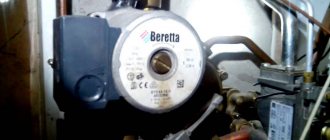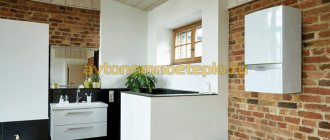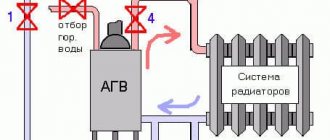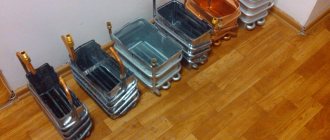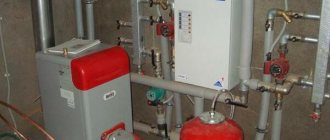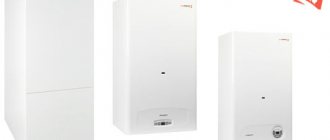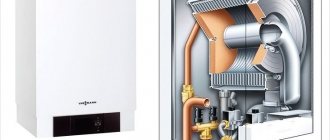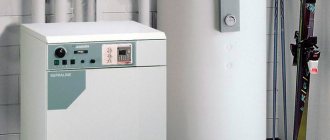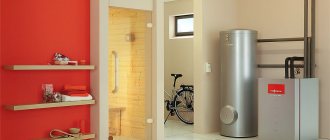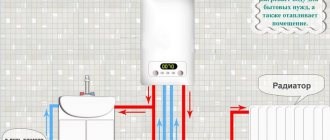Dimensions and weight
Dimensions are one of the most important differences between wall-mounted and floor-standing gas boilers. The dimensions and weight of wall-mounted models are much more modest, otherwise it would simply be impossible to mount them on the wall without the risk of collapse. The lightness of the design is achieved not only by the overall compactness of wall-mounted models, but also by the material from which the heat exchanger is made.
For wall-mounted models, the heat exchanger is made only of steel; floor-standing models may have heat exchangers made of cast iron, which is significantly heavier, or steel.
Wall-mounted boilers are often called mini-boiler rooms. And this is no coincidence, because a relatively small-sized housing houses not only the burner, heat exchanger and control system components, but a circulation pump, expansion tank and other elements without which the operation of a conventional boiler room is indispensable. The compactness of the wall-mounted boiler is its main and undeniable advantage. There is no need to allocate a separate room for such a device, because it can be placed anywhere, for example, in the kitchen.
Wall-mounted gas boiler with a coaxial chimney, located in the kitchen.
Floor-standing models inspire confidence with their size. This is exactly what a powerful boiler should be, providing the ability to heat a large building. However, the dimensions of floor-standing boilers often turn into a problem for their owners. Sometimes, in order to bring such a “giant” into a room, you have to dismantle the doorways. There were cases when, due to the impossibility of bringing equipment into the boiler room, the purchased floor-standing gas boiler had to be replaced with two smaller ones.
Floor-standing gas boiler and indirect heating boiler.
Advantages and disadvantages of wall-mounted gas boilers
If you are interested in which boiler is better, you need to study all the pros and cons of wall-mounted devices. Their key advantage is almost complete automation using volatile systems.
The design provides for a pump and an expansion tank. There are many small elements and parts that contribute to the efficient and economical operation of the equipment.
Option for a wall-mounted boiler in the kitchen
The units are highly economical, and the difference in energy savings with wall-mounted boilers reaches 10-15%. Similar results are typical for models operating on the condensation principle and equipped with turbocharging. Other benefits include:
- Compact overall dimensions and weight. The medium-power model weighs no more than 50 kg and has small dimensions, which simplifies the installation and maintenance process. The presence of an installation in the bathroom or kitchen does not detract from the organic style of the interior, since it does not differ from a simple wall cabinet. Modern products have a presentable design and fit into any style of room.
- Possibility of installing a unit with a closed combustion chamber in any part of the outbuilding.
- Good work productivity. The main market share is occupied by double-circuit boilers, which are capable of heating a building and at the same time solving the problems of hot water supply.
- Easy to choose. Even an inexperienced consumer can calculate kW power for every 10 m².
- Optional installation of additional devices. Modern manufacturers market products with a closed combustion chamber, so coaxial chimneys are already included. They are a small pipe for removing carbon monoxide, which does not take up much space, but demonstrates high efficiency.
- Wide functionality - modern installations operate on the basis of weather-dependent automation, are able to connect to the Internet and are controlled by a remote control or smartphone.
Among the disadvantages, there are a number of costs associated with arranging a complete set and using automation with a microprocessor chip. Because of this, a wall-mounted boiler is used less often than a floor-standing one, because... For many consumers, cost is a key selection criterion.
When choosing between wall-mounted and floor-mounted units, you need to take into account the following disadvantages of the first type of system:
- Energy dependence. The boiler has 1-2 circulation pumps that operate non-stop. The design also provides for the presence of sensors and automation, which require constant voltage.
- The microprocessor reacts negatively to network interference. Any surges or failures contribute to the controller burning out, which entails the need for expensive repairs.
- The equipment is equipped with complex automation systems, which often break down and malfunction. Restoring them with your own hands is problematic, and there are few experts involved in setting up and repairing equipment.
Equipment
The factory configuration of a wall-mounted gas boiler, as a rule, includes not only the heating device itself, but also a circulation pump, an expansion tank, control system elements, and all the necessary sensors and valves. Moreover, all this is hidden in the body of the boiler itself.
By purchasing a wall-mounted gas boiler, you get a miniature boiler room for your use, that is, the minimum set that, after connecting to the heating system, is able to begin full-fledged work on heating your home.
Of course, if you wish, you can additionally purchase all kinds of room thermostats and regulators, outside temperature sensors, a GSM communication module and much more, improving the heating system of your home and increasing the comfort of its control.
A floor standing boiler is usually just a boiler. Circulation pumps, an expansion tank and many other related equipment are not included in the delivery package - you will have to purchase everything you need separately.
Wall-mounted gas boiler with lid removed.
"Pros" and "cons" of floor-standing gas boilers
Now we will familiarize ourselves with a floor-type heating boiler powered by gas. It is a non-movable heat generator, which includes components and mechanisms that are necessary to heat the thermal fluid.
So, let's start with the advantages of this equipment:
Long service time. This is achieved due to the fact that the device is equipped with a heat exchanger of the highest quality, usually made of cast iron. The service life of such a boiler is on average 45 years.
Unlimited production. Even when the housing area exceeds 1002 m, one boiler will be enough.
Can be installed in a heating system with both forced and natural circulation.
However, this model also has disadvantages:
Large weight and dimensions. To install a gas floor-standing boiler, you need a separate room that will meet the requirements of SNiP and have certain dimensions.
Long installation time. Installation of this device will take about 4 hours. This process must be entrusted to professionals, as numerous checks and testing of the equipment and the system as a whole are required.
Such a boiler cannot be used in the case of coaxial (exiting into the wall) chimneys.
High price. Be prepared to spend a lot of money.
Easy to install
Which boiler, wall-mounted or floor-mounted, is easier to install? It would seem that this question should concern not potential owners of the unit, but exclusively the craftsmen who will be involved in deploying the heating system. However, do not forget that the buyer, that is, you, will have to pay for this, and the more labor-intensive the work, the more money you will have to part with.
In terms of ease of installation, the wall-mounted boiler is the undisputed leader. In the case of a floor-standing unit, you will have to equip an entire boiler room, because in addition to the boiler itself, you will have to install circulation pumps, an expansion tank and, perhaps, a boiler. The scope of work, as you might guess, differs very significantly, and the cost of the work will vary just as much.
Life time
When purchasing any equipment, especially expensive equipment, we want it to serve, if not always, then at least for as long as possible. This fully applies to gas boilers. Which boiler, wall-mounted or floor-mounted, will properly heat our home for many years?
The service life of a gas boiler is primarily determined by the service life of its heat exchanger. There is currently no consensus on which heat exchanger material is better - each has its own advantages and disadvantages.
In floor-standing models, cast iron heat exchangers are usually installed. Cast iron is less susceptible to corrosion, but at the same time it is fragile, which means there is a risk of microcracks forming during transportation. In addition, it does not tolerate sudden changes in temperature. When hard water is used as a coolant, the cast iron heat exchanger slowly deteriorates as a result of scale formation and, as a consequence, local overheating of the material.
Cast iron heat exchanger.
Cast iron heat exchangers are not suitable for wall-mounted gas boilers, because they are too heavy. The most preferred material in this case is steel. The latter is not afraid of shocks during transportation, but is highly corroded during operation, especially incorrectly.
Steel heat exchanger for a gas boiler.
So which heat exchanger is better? Since the boiler does not have to be transported very often, the factor that has the greatest impact on the service life of this structural element can be considered corrosion resistance. From this we can conclude that a longer period of normal operation can be expected from a floor-standing boiler with a cast iron heat exchanger.
We should not forget that the service life of the boiler is also affected by the wear of other structural elements - circulation pumps, gas valve, electronics, etc. The quality of the unit depends on the quality of each of its individual components. Practice shows that the average boiler from a well-known manufacturer who cares about the reputation of the brand will serve you well for 15-20 years, no matter whether it is wall-mounted or floor-mounted. No one knows what to expect from a “no name” unit.
Of course, in order for heating equipment to work long enough, you should follow all the manufacturer’s recommendations regarding operating conditions and carry out the necessary maintenance in a timely manner. The user can cope with many problems that arise on his own thanks to the self-diagnosis tools available in modern equipment.
Boiler with the best gas consumption
When comparing gas boilers with each other, you will probably ask the seller: “what gas consumption will my 100-square-meter house have with your boiler?” The seller of brand X boilers will tell you that the consumption will be 5-6 cubic meters per day, and the seller of brand Y will give a figure of 7-8 cubic meters. You will be happy to buy the one in which the consumption will be less.
Do you know what your mistake will be? The fact is that you asked this question at all. Because not a single seller will give the correct gas consumption figure. Today, the reality is that gas consumption depends not so much on the boiler, but on the heat loss of your home. And every home will have their own!
The boiler itself performs the function of compensating for heat loss. From here, remember the main thing: when choosing a gas boiler in the same price segment from classmates, you will get similar gas consumption. Now these figures have long been equal for all brands. Therefore, you don’t have to worry too much about consumption.
Coolant quality
The service life of a gas boiler and its output directly depend on the quality of the coolant. Using water with increased hardness as a coolant leads to the formation of scale inside the heat exchanger. Scale, in turn, causes a significant decrease in boiler efficiency and, as a consequence, an increase in fuel consumption.
The heat exchanger of the gas boiler is clogged with lime.
Both floor-standing and wall-mounted boilers “suffer” from scale to approximately the same extent; only the level of difficulty in solving an existing problem differs. The ease of disassembling and washing the steel heat exchanger of a wall-mounted boiler allows you to quickly restore the functionality of heating equipment right at the installation site.
Washing the cast-iron heat exchanger of a floor-standing boiler is difficult and, moreover, not always possible (many manufacturers insist that its disassembly and assembly be carried out exclusively in the factory). Most often, a faulty or clogged cast iron heat exchanger simply has to be replaced, and this part is by no means cheap.
It follows from this that installing a floor-standing boiler with a cast iron heat exchanger requires that you have a chemical water treatment plant. This device is not cheap, but in this case it is extremely necessary.
Types of gas boilers
General gas boiler systems can be single-circuit or double-circuit.
A single-circuit boiler only heats the house, while a double-circuit boiler solves two problems at once: heating and water heating. In this case, the choice should be made based on your everyday needs.
Floor-standing and wall-mounted gas boilers can be single-stage, two-stage and modulating. The latter of these are more profitable to use, as they allow the boiler to operate at less than full capacity even in severe frosts. This will significantly save your money, especially in regions with cold winters.
Another boiler can be connected to a boiler with a two-stage system. Also, this type of boiler will save gas and last much longer, unlike a single-stage one.
Dual-fuel boilers can operate on both gas and diesel fuel. These models are the most popular. They are economical, safe and silent. However, the owner of such a device must constantly monitor the pressure gauge readings so that the pressure in the system corresponds to the norm.
Power modulation
Depending on the implemented method of regulating the flame intensity, all boilers are divided into boilers with a stepped or modulating burner. One- and two-stage burners have one or two operating modes, respectively (usually 100% and 70% of maximum). The power of modulating burners can be smoothly adjusted over a fairly wide range, which allows fine-tuning the operation of the boiler. Modulating burners provide fuel savings and allow you to maintain the set temperature with minimal deviations.
A significant part of floor-standing gas boilers are equipped with one- or two-stage burners. Most wall-mounted models have a wide range of power modulation (from 40 to 100%), due to which they operate “softer” - they turn on and off much less frequently than boilers with stepped burners.
Advantages and disadvantages of floor-standing boilers
First, about the advantages of floor-standing units. Here is their list:
- There are many chimney models whose operation does not depend on electricity. This is the most reliable boiler for a private home located in an area with unreliable power supply;
- Structurally, the heat generator is simpler and more reliable than its “brothers” that are hung on the wall.
- low-power heat sources do not have to be located in the furnace room; they can be installed in any room where there is a good chimney;
- the stationary version is easier to connect with other boiler systems using separate circulation pumps.
- when high heating power and significant water consumption are required for domestic hot water needs, a floor-standing gas boiler is the best solution.
Regarding installation work. This is not to say that installing a stationary unit will cost more than hanging and connecting a wall unit. Indeed, in the latter case, you need to carry out work on finishing the room or assembling the cabinet. So it all depends on individual conditions.
Atmospheric heat generators placed on the floor require a chimney; this is their main drawback. If the cost of a boiler is cheaper than a suspended one, then the installation of a chimney pipe will more than cover this difference. The conclusion is the following: when the house already has a smoke shaft, then you can buy an atmospheric stationary model. If there is no chimney, then it is worth choosing a turbocharged version - floor-mounted or suspended, depending on the required power.
Energy independence
For some consumers, an important parameter of a gas boiler may be the dependence of its operation on electricity. The energy independence of heating equipment is relevant for those whose house or cottage is located at a considerable distance from large populated areas, i.e. in places where power outages or power surges in the network are possible, leading to the failure of expensive automation.
Autonomy of a gas boiler can be achieved in two ways. The first is to simplify the boiler control system as much as possible. That is, it is necessary to use a unit in which there is no electronics at all. All automation of such a boiler is mechanical. A heating system that uses a similar boiler that operates without electricity must have natural circulation.
The second method is to use an electric generator, which converts the heat obtained by burning gas into electricity necessary for the operation of the boiler automation. This option is preferable for most users because it creates fewer restrictions.
You can find energy-independent models only among floor-standing gas boilers, which for some buyers will be a strong argument in favor of the latter.
Choosing the best equipment
When evaluating different modifications of heating equipment, the consumer will most likely look at the price tag first, and then at the characteristics of the product. If the goal is to purchase a cheap device, it is better to pay attention to wall-mounted options. If you need power and reliability, then the best choice is floor-mounted structures. For a more in-depth analysis of the models, it will be necessary to compare a number of technical indicators of the units: equipment, energy independence, cost, safety and power modulation.
Dimensions and weight
Dimensions are the main difference between modifications of boiler units. For the former, they are much more modest, otherwise they simply could not be fixed to the walls without the danger of destruction. The portability of the unit is achieved not only by the small size of the wall modifications, but also by the type of metal from which the heat exchanger is made. For mounted units it is made of steel, and floor-mounted structures are equipped with heavy cast iron boilers.
However, the large size of floor-standing units often results in difficulties for their owners. Sometimes, in order to bring such a “giant” into the furnace room, it is necessary to disassemble the doorways.
Life time
The period of operation of any boiler unit is primarily determined by the duration of operation of the internal heat exchanger. In floor modifications, cast iron heating surfaces are mainly placed. This material is more durable, less susceptible to corrosion processes from the effects of thermal coolant, but at the same time it is a very brittle metal, and therefore there is a danger of microcracks appearing during the transportation of the product or under the influence of water hammer in the heating network, which usually arise when operating conditions are violated operation of boiler equipment, especially during cold start-up. To increase the service life of wall-mounted models, install copper heat exchangers.
According to operating experience, economy class models with steel heaters usually last from 7 to 12 years. Middle-class modifications of the average cost group with copper boilers will last 15–20 years, and expensive floor-standing models with a cast iron boiler will last from 20 to 25 years.
Easy to install
Since floor units are characterized by a significant mass of 60–100 kg on average, this imposes an obligation to perform pre-installation reinforcement of the floors in the area where the equipment is located, and sometimes, according to the requirements of the manufacturer, it is necessary to perform an individual permanent brick or concrete foundation. Plus, it must be fireproof.
Wall modifications have a weight not exceeding 30–40 kg. For their installation, fasteners from good quality anchor bolts are used, and the wall for placement should not be a lightweight partition, but a solid one made of 2 brick rows or monolithic concrete. Fire safety for these units is ensured by a fire-resistant substrate between them and the wall. In addition, it is necessary to adhere to the recommended minimum intervals from current sources and furniture - at least 500 mm.
Based on practice, the mounted boiler unit is the undisputed leader in ease of installation work. In the version of the floor-standing device, the user needs to equip a real boiler room, with a circulation pump, an expansion tank and an external boiler for heating water. The amount of work for such modifications of units increases very significantly, along with the cost of installation.
Power modulation
Based on the performed method of adjusting the intensity of gas combustion, all units are divided into devices with a modulating burner and options with several stages of operation: one- and two-stage burner devices at 60 or 100% of the operating rate. The thermal performance of modulated gas burner devices has the ability to smoothly regulate the load over a very wide range, which makes it possible to fine-tune the functioning of the equipment. Such devices guarantee savings in fuel and energy resources, allowing you to maintain the desired temperature conditions with the smallest deviations from operating parameters.
A large number of floor-standing boilers are equipped with 1 or 2-stage burners. The vast majority of wall-mounted options have a modulation power control mode from 40 to 100%.
Energy independence
For many buyers, the fundamental parameter of a boiler running on gas fuel is its dependence on the power supply. This parameter is especially important for subscribers whose home is located far from power lines, have a limited connected load, or in areas where power outages are likely or voltage drops in the power grid often occur.
Autonomous operation of the boiler can be implemented in 2 options. The first consists in the extreme simplification of the unit for adjusting the modes of the boiler unit, which does not contain electronics. The control of such a unit is mechanical. This system is more suitable for floor-mounted structures, provided that the heating operates on the principle of natural coolant movement.
The second option is the use of an electric generator, which converts the acquired heat from gas combustion into electricity needed for the operation of the automatic control of the unit; this option is most feasible in wall-mounted modifications.
Floor-standing atmospheric or wall-mounted condensing boiler
These two types of floor and wall units are the most promising and preferred by consumers. A floor-standing gas boiler is considered an atmospheric convection unit and operates without pressurizing air into the firebox, due to the draft created by the chimney. It belongs to non-volatile options. A wall-mounted or gas condensing boiler operates using additional heat from the condensation of flue gases in the tail surfaces of the boiler unit.
When burning the same volume of gas fuel, condensing units produce twenty percent more thermal energy than a traditional boiler. This result is obtained by connecting an auxiliary heat transfer device to the boiler heating system - a water economizer, which reduces the temperature of the flue gases to the vapor condensation temperature of approximately + 55C.
A wall-mounted or gas boiler with condensation is a new type of heating equipment, the main advantage of which is considered to be high efficiency. Manufacturers say that the efficiency of such boilers can reach up to 110%. Although it is clear that from a physical point of view this is unimaginable. In fact, this refers to a new version of calculating efficiency, which takes into account the entire heat balance of the boiler. In older modifications, the heat from condensation was simply not taken into account when calculating efficiency. However, a condensing boiler actually works much more efficiently if both boilers are calculated using the same formula, the condensing unit has an efficiency of 95%, and convection devices have no more than 85%.
Installation site requirements
Before choosing a floor-standing or wall-mounted gas boiler, you should resolve the issue regarding its installation location.
Due to its compactness, the wall-mounted boiler can be placed in almost any room. The main thing is that a number of requirements are met to guarantee the safety of its operation: a closed combustion chamber, connection to a coaxial chimney, forced removal of flue gases and injection of air to maintain the combustion process. Installing a boiler with an open combustion chamber in a kitchen where there is a hood is unacceptable, since in this case a so-called “draft reversal” is possible, in which the smoke from the boiler will not go into the chimney, but into the room.
There are not many options for placing a floor-standing gas boiler. Due to the size of the boiler itself, as well as all kinds of related equipment, we can only talk about a separate room - the boiler room. Despite the fact that the boiler room does not belong to residential premises, when installing a gas boiler, it is necessary to ensure normal removal of fuel combustion products and air flow.
Overview of both types of units
The main feature that distinguishes a floor-standing gas boiler is that it is equipped with a cast-iron fire-tube heat exchanger; steel ones are practically not found in these heat generators. It is a chamber filled with water and penetrated by vertical channels. Hot combustion products pass through them, releasing thermal energy to the water through the cast iron walls. In addition, the heat exchanger is heated from below by the burner flame.
Floor-standing gas boilers intended for heating private houses can be divided into 2 categories:
- budgetary;
- expensive units with an expanded range of functions.
When choosing a wall or floor heat source, homeowners most often lean towards budget heat generators. And not only because of cost, but also due to their simple design. In addition to the heat exchanger and burner device, such a heating unit is equipped with a minimum set of automation required by gas supply regulations. Moreover, the device is equipped with an open combustion chamber, and the range of offered powers is quite wide - from 7 to 200 kW or more.
Expensive models have a full range of various automation systems that allow you to program the operating modes of the heat source, connect room thermostats and weather sensors, and also control the heating operation remotely. Such gas boilers are equipped with a closed combustion chamber with forced air supply; some modifications are equipped with a second circuit for heating water for domestic hot water needs.
Wall-mounted heat generators are equipped with steel heat exchangers and are offered in various designs:
- with an open or closed combustion chamber;
- with a minimum set of automation or with a wide range of functions;
- equipped with additional equipment that turns the boiler into a mini-boiler room.
The last option is units that have their own circulation pump and expansion tank installed inside them. If you review all floor-standing models from different manufacturers, you will find that a built-in pump and tank are quite rare in them. When choosing a stationary or wall-mounted boiler, owners of apartments and country cottages pay attention to this point.
Power
The power of wall-mounted gas boilers, as a rule, varies from 10 to 40 kW. This, according to a rough estimate, is enough to heat a home with an area of 100 to 400 square meters. m. However, if part of the heat is used to heat water for domestic needs, then this power will be enough to heat only a relatively small house.
The capabilities of floor-standing gas boilers are significantly higher. The power of floor-standing models can reach 80-100 kW, and if it is equipped with a forced-air burner rather than an atmospheric one, then even more. If you need to heat a huge house or industrial facility, then a floor-standing boiler is exactly what you need.
What to choose
For clarity, let’s make a table of the features of both types:
| Characteristics and Features | Wall mounted | Floor-standing |
| Functionality | Full set | |
| Durability | Depends on the operating mode. On average, from 10 to 20 years | |
| Power | Up to 50 kW | Up to 500 kW |
| Power supply | Energy-dependent designs | Volatile and non-volatile designs |
| Price | Average | Medium and high |
| Weight, dimensions | Small, medium | Medium, large |
| Difficult to manage and maintain | Average | |
Final comparison of wall-mounted and floor-standing gas boilers
| Wall-mounted gas boiler | Floor standing gas boiler | |||||||
| Dimensions | Less | More | ||||||
| Weight | Less | More | ||||||
| Equipment | The boiler is equipped with additional equipment | Additional equipment must be purchased separately | ||||||
| Easy to install | Easier | More difficult | ||||||
| Life time | Steel heat exchangers are more susceptible to corrosion, which reduces service life | Units with a cast iron heat exchanger can operate for a longer time | ||||||
| Coolant quality | The dependence on the quality of the coolant is high, but it is easier to flush the heat exchanger | The dependence on the quality of the coolant is average, but it is more difficult to flush the heat exchanger | ||||||
| Power modulation | More possibilities | Fewer features | ||||||
| Energy independence | Fully volatile units | There are non-volatile units | ||||||
| Installation site requirements | Less | More | ||||||
| power, kWt | 10 — 40 | 80 — 100 | ||||||
| Price | Below | Higher | ||||||
If you notice an error, a non-working video or link, please select a piece of text and press Ctrl+Enter .
0
Differences between floor and wall gas boilers
The difference between these modifications of boiler units is contained in their internal arrangement and configuration. The principles for generating thermal energy are similar. Wall-mounted options have very good equipment: an automatic safety and regulation unit with primary sensors for monitoring process parameters, a circulation pump, an expansion tank to protect the structure from excess pressure when heating the medium and other equipment necessary for operation.
The floor-standing equipment is equipped with a powerful cast-iron heat exchanger, which has the longest service life of all existing analogues today. Auxiliary equipment: pumps, smoke exhausters, fans, mud collectors are equipped according to the external installation option. Often an additional tank with indirect water heating is purchased for these boilers.
Advantages and disadvantages of wall-mounted and floor-mounted boilers
Like all modern thermal power equipment, both types of boilers have their own advantages, which the buyer should know before deciding which boiler is better.
The advantages of wall modifications include:
- Small size, light weight, the ability to fit harmoniously into the interior of even the smallest room;
- the widest range of functionality and thermal performance;
- operational reliability, stability of operation;
- ease of regulation;
- low gas fuel consumption;
- practicality, accessibility of maintenance and repair work.
The disadvantages of wall-mounted units are the limited upper limit of their power due to the requirement to reduce the load on load-bearing walls, as well as the need to use specialized equipment when setting up the boiler.
Floor-mounted ones have been used for quite a long time, so they are structurally more advanced.
The advantages of floor-standing boilers include:
- Highest thermal power, the ability to heat objects of impressive size;
- strength, endurance to operational loads;
- the ability to combine different models into a high-performance complex;
- a limitless range of types with different design qualities and performance;
- ease of installation;
- workflow management is clear and accessible to every customer.
The disadvantage of this design of boiler units is the need to arrange a separate combustion room with glazing and locking doors.
